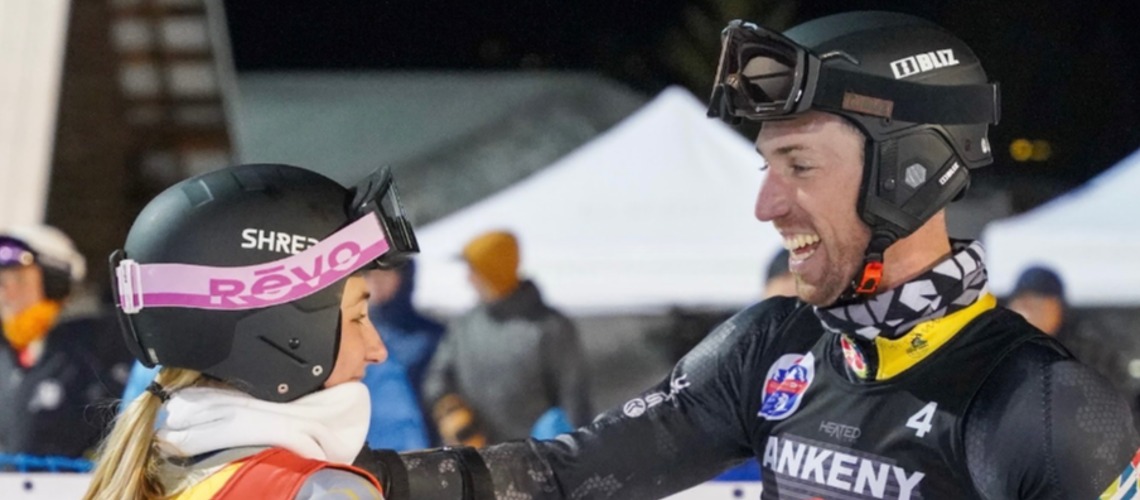Report - WPST Steamboat Springs Winter Carnival Cup + Rocket Mortgage Women's Tour

Always hammering and in the mix of top contenders, former U.S. Team skier Michael Ankeny hadn’t found the top step of the World Ski Tour podium in a couple of years. Then he rolled into the third stop in the 2022 series on Saturday, tackling the steepest, most technical course thus far at Howelsen Hill in Steamboat Springs. He was out for blood from the get-go.
“I was definitely on a mission today,” said Ankeny, 31, who had clinched two podiums before the Steamboat Winter Carnival Cup this season, but came in determined to make it beyond the Consolation Round. “I knew if I executed my game plan, I could at least be in the conversation.”
As the third qualifier, Ankeny fired into the Round of 16 under the lights at Howelsen Hill, handily defeating Ben Andrews before taking on Tucker Marshall in the quarter finals. Marshall put up a solid fight, even leading momentarily before Ankeny surged ahead. As he often has, Ankeny faced World Pro Ski Tour leader and 2021 defending champion Rob Cone in the semi-finals, but managed to squeak by in both runs by no more than two tenths of a second.
In the finals, Cone squared off against Simon Breitfuss Kammerlander, who had arrived in Steamboat directly from the Beijing Olympics, where he competed in the downhill and super G races for his home country, Bolivia.
In a squirrely display of athleticism, Ankeny charged down the steep course, launching off of the second jump with so much height that he found himself rolling up the windows in mid-air before landing and quickly redirecting his skis to make the next gate. By the final run, he had steadied his technique, clearly crossing the line ahead of the European for the big win.
“I almost went over the tips there,” Ankeny said of his wild jump. “I love this hill. It’s different than the first two hills we skied, which have their own challenges. Here, you have gravity helping, but it’s much more technical vs. power. I’ve lost a bit of my power since I stopped skiing, but haven’t lost too much of the tactical-technical side, so I was really excited coming back here.”
Notching a handful of World Cup starts during his time racing for the U.S. Team, the 31-year-old Minnesota native and former national junior slalom champion landed a career best 19th place in the Kitzbuhel World Cup slalom in 2016.
Back from the biggest stage of all in Beijing, Kammerlander said he “felt a little drunk,” as the heats went by on Saturday, having just arrived back into the U.S. from the Winter Games on Friday.
“We were around the world completely,” Kammerlander said. “We had to get back from Beijing to Paris, Paris to Atlanta, Atlanta to Denver, so it was a crazy trip. Then it was the 15 hours time difference. I was good this morning until the qualification runs. Later on in the afternoon, I felt so tired, I was just drinking energy drinks. This hill, it’s tough ski racing. I felt so tired. I was not in balance, I was everywhere, back-forth, in-out. For sure, second place was the best for me for today.”
The crazy stunt of the day went to Colorado skier Tanner Perkins as he went up against Kammerlander in the semi-finals. After Kammerlander slipped past him in the first run, Perkins was fighting furiously to make up for lost time and launched so far off of a jump in the second run that he couldn’t correct in time to clear the gate on the landing, crashing directly through two panels and lying on the snow for a couple of seconds before slowly rising.
He still managed to take on Cone in the small final, but couldn’t keep up the fight. Cone rounded out the podium as Perkins took fourth.
Buoyed by his first Pro Tour win in two years on Monday night at Howelsen Hill in the Moose Barrows Trophy, presented by DNA Vibe. The 31-year-old Minnesotan rode that mental boost – along with his trademark hammer-down style – to another victory on Tuesday.
“It’s huge,” Ankeny said of the power of confidence. “In skiing, you get to a certain stage and everyone’s good. Everyone knows how to arc a turn. Everyone knows how to handle a jump, but it’s the mental aspect that counts. Over the last couple of years, I’ve been in a bit of a rut, against Rob in particular.”
It was defending World Pro Ski Tour champion and leader Rob Cone who found himself in an actual rut on Tuesday night in the final run, closing the gap that Ankeny had created in the first run when he suddenly hit a rut mid-course, abruptly and unwittingly exiting the gates.
“I was kind of arguing with the course yesterday and today because there were deep, Colorado ruts here,” Cone said afterward. “That final run, I was coming back to Michael. I knew I was even closing in on him, then [with] a little bit of tactics, I wanted to just run it as straight as possible to cut line. That’s kind of why I bounced into that rut.”
Other than booting out similarly during a qualifying run on the same course at Howelsen Hill a couple of seasons ago, Cone cannot recall a single run other in his three years of racing on the Pro Tour in which he has skied off-course. Taking second place following Monday’s third place, Cone has landed on every Pro Tour podium this season, but after his back-to-back wins, Ankeny now takes his place as the man to beat.
As it turns out, Ankeny hit a small rut himself in Tuesday’s final run, but managed to stay on course through the finish line.
“That bobble happened right after Rob had his,” Ankeny said. “I had a comfortable lead after the first run. All I was telling myself was, ‘keep attacking,’ because as soon as you take off the gas pedal, that’s when you can get into trouble. At the second gate I slipped a little bit, then I said, OK, let’s get back into it. Rob was coming back. Then, out of the corner of my eye, I saw this plume of snow come up. I was like, oh crap, Rob just messed up. Right when I thought that, I got a little distracted, then went out the back seat.”
As for how he’ll use the $20,000 in prize money he collected over two days of racing, Ankeny said he’s looking forward to splurging.
“I’m going to take my girlfriend on a nice little golf trip, get out of the Minnesota cold,” he said. “I’m going to enjoy that money.”
The race for third place proved nearly as exciting on Tuesday. Monday’s runner up Simon Breitfuss Kammerlander, struggling through jet lag after returning from the Beijing Olympics on Friday, faced Pro Tour rookie, former Norwegian National Junior Slalom Champion Wilhelm Normannseth. The two Europeans fired down both Small Final runs with nearly perfectly synchronized carving, Normannseth edging Kammerlander by about a tenth of a second in each run to round out the podium.
The Norwegian, a successful competitor for the University of Utah, said he decided to make the trip to Steamboat after hearing good things about the Pro Tour from fellow university athletes who had raced in the previous stop in Aspen. He said prior to Monday’s competition, he hadn’t raced in a dual format since winning a Norwegian Championship dual slalom race in 2017, but now that he has the hang of it, plans to become a familiar face on the Pro Tour.
“In general, ski racing is a really serious, super stiff kind of sport,” Normannseth said. “I think that’s why it doesn’t bring in the same amount of money as football or basketball or those big sports. I think if you could make more of a show out of it, it would perform way better on the TV, with a crowd. What they’ve got here at the World Pro Ski Tour is incredible. That’s what I like about it, why I’ll ski a lot more of it in the years to come, I hope.”
Norbye two-for-two on World Pro Ski Tour
The Norwegian is officially out of retirement in dual slalom racing
After crashing across the finish line to victory in her first ski race after she had “retired” from the sport last month in Aspen, Norway’s Tuva Norbye decided she’d better stop using the “R” word as well as put some time in the gym before signing up for the next World Pro Ski Tour women’s race in Steamboat Springs.
She not only managed to stay on her feet through every round of dual slalom action on Howelsen Hill on Saturday, but the University of Denver graduate found extra strength to once again finish on top, landing yet another $10,000 check for her effort.
“I crashed through the finish at the last race because I was so tired. Since Aspen, I’ve been doing some more workouts, definitely got my legs in shape,” said Norbye, who is pursuing a post-graduate degree at the University of Utah. “I haven’t done any heavy lifting, but have been working some muscles in my legs. I knew I could finish the whole day without crashing. That’s been a big advantage, also being excited about this race because I’m a Tour member now. It’s been cool building up to this race.”
Although she has spent time in the gym, Norbye said she’d only been on skis once since last month’s women’s Pro Tour opener in Aspen.
“I’ve skied so much my whole life, just getting one day on these skis was enough,” she said. “I kind of thought I had more of an advantage in Aspen, where it was flatter, but throughout the day, I figured out this course and was able to push it the last couple of runs. I got better and better throughout the day, which was a cool experience.”
The fourth seed of eight qualifiers going into the first heat, Norbye took down Slovakian Sona Moravcikova by only about a tenth of a second before squeaking by No. 1 qualifier, the University of Utah’s Katie Vesterstein in the semifinals. In the final round, Norbye truly met her match in University of Denver’s Galena Wardle, who arrived to Steamboat fresh off of a pair of top 10 finishes in Nor-Am tech races in Canada.
Norbye pulled ahead of Wardle by about a tenth of a second in the first run and after Wardle slipped up at the top of the course in the last and final run, looked like she’d run away with it. That’s when Wardle somehow scrambled to match strides again, making for a photo finish and a Norbye victory by mere thousandths of a second.
“I think I’m good at fighting back,” Wardle said afterward, walking away with $4,200 for second place. “Honestly, I feel like I fought for every run tonight. Nothing was a clean run or an easy run at all. I’m pretty sure I didn’t win a single first run. I was always fighting.”
Story courtesy of Shauna Farnell and Ski Racing Media














